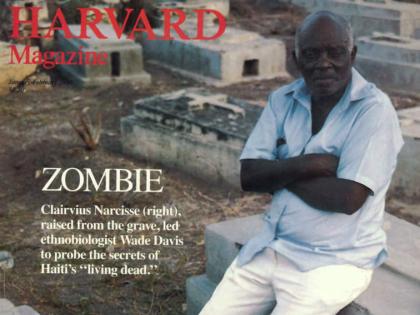Eurodisney was greeted in Paris as a "cultural Chernobyl," but that may be nothing more than French chauvinism. For contrast, consider that Tokyo Disneyland's opening in 1983 was later hailed as nothing less than "the most important cultural event of the eighties in Japan." With 125 million visitors in its first 10 years,Dizuniirando (as it's rendered in Japanese) is the most popular diversion in Japan. Its yearly attendance tops every amusement park in the world, including the two U.S. Disney parks. What explains this curious cultural fit? Has American pop culture finally conquered Japan, or has Japan beaten the United States at its own game?
Neither, according to cultural anthropologist Aviad Raz, a postdoctoral fellow at the Reischauer Institute of Japanese Studies. In his telling, the story of how "Japan" meets "America" in the secular holy land of Mickey Mouse isn't the old story of cultural imperialism, but the contemporary tale of "how a significant piece of American business, ideology, and fantasy has been remade in Japan." Raz's ethnographic study of the cultural consumption of Disneyland includes interviews with more than 60 employees, visitors, journalists, scholars, and "imagineers" (Disney engineers). He also gathered data as a ride-going participant-observer, camcorder in hand.
Tokyo Disneyland--owned, operated, and licensed by a Japanese company--claims to be a "100 percent copy" of the American original, but Raz found a much more complex "local adaptation and active appropriation of Disney by the Japanese." High-tech rides such as Splash Mountain--a universally popular "screamer," in Disney talk--need no translation. But "dreamers," rides that rely on narrative and atmospheric effects, necessitate a cultural rewrite, Raz explains. Jungle Cruise, for instance, resurfaces in Tokyo with a brand-new wrapping: its script or "spiel" is replete with Japanese puns in place of the original American wisecracks.
Other "dreamers," Raz discovered, are unique to Tokyo Disneyland. The Cinderella Castle Mystery Tour, for example, borrows Disney characters and technology, but belongs in the Japanese tradition of the "ghost house": children taking the tour often mistake Disney's Black Ghost, from the film The Black Cauldron, for Oni-san, a Buddhist demon who is the villain of Setsubun, the holiday that celebrates the defeat of winter and the arrival of spring. Meet the World, on the other hand, is wholly Japanese, Raz explains, in its "optimistic and selective story of Japan's encounters with the world," and Main Street, USA--which serves as a "repository for pre-urban Anglo-American nostalgia" in the original Disneyland--is remade in Tokyo as the World Bazaar, a "longing for a future which is not yet here."
World Bazaar also satisfies the deep Japanese hunger for souvenirs, making it the most successful retail space in Japan. Tokyo Disneyland owes that honor in large part to its cachet among Japan's "office ladies," young women living at home who work as receptionists and typists until they marry. With plenty of disposable income, these so-called "flowers of the office" (pretty but ephemeral) have become a major target market, with unique "cultural styles of consumption and self-expression," Raz says. One such style is burikko, or pretending (buri) to act like a child (ko). Another is kawaii, or "cute." Together, these behavioral codes create the favorite expressive idiom among "office ladies"--kawaiiko burikko, or pretending to be a cute child.
Because Japan's image of the sexy woman (and good wife) is still the high-school girl, the quintessential burikko style requires collecting toys, wearing girlish clothing, and "giggling and squealing in a high-pitched voice," Raz notes. It's no surprise that Tokyo Disneyland is the first choice for first dates. "If a guy takes me to Disney it represents a kind of investment, it means he's serious," one informant told Raz. On weekdays, 40 percent of the park's visitors are "office ladies" on dates. Overall, they constitute 30 percent of Tokyo Disneyland's "repeaters" and 60 percent of its consumers of things Disney. Rooms with Disney themes are also in high demand in Tokyo's "love hotels," where young people who live at home can rent rooms by the hour.
The prima facie evidence suggests that Disney has simply finished the job begun by Commodore Matthew Perry. In 1853, Perry anchored four ships of the U.S. East Indies Fleet in Tokyo Bay and demanded the right to trade with Japan, effectively ending Japanese isolation and spurring modernization. These infamous "black ships" quickly became the symbol of coerced Americanization and foreign influence, Raz says, explaining why Tokyo Disneyland was nicknamed kurofune (black ship) by its Japanese competitors.
But "we can't really speak of Americanization here," he argues, "because what we see is not cultural imperialism but local adaptation." (The current buzzword, he notes, is "glocalization.") Tokyo Disneyland, he says, allows us to redefine globalization, the spread of cultural homogeneity, as "the dynamic, bilateral flow of culture among first-world cores such as Tokyo and Los Angeles." Dizuniirando even appropriates Perry's black ships for its own upbeat history in Meet the World, Raz concludes, so that "even if Tokyo Disneyland is a black ship, it is the Japanese who are steering it."
~ Harbour Fraser Hodder







